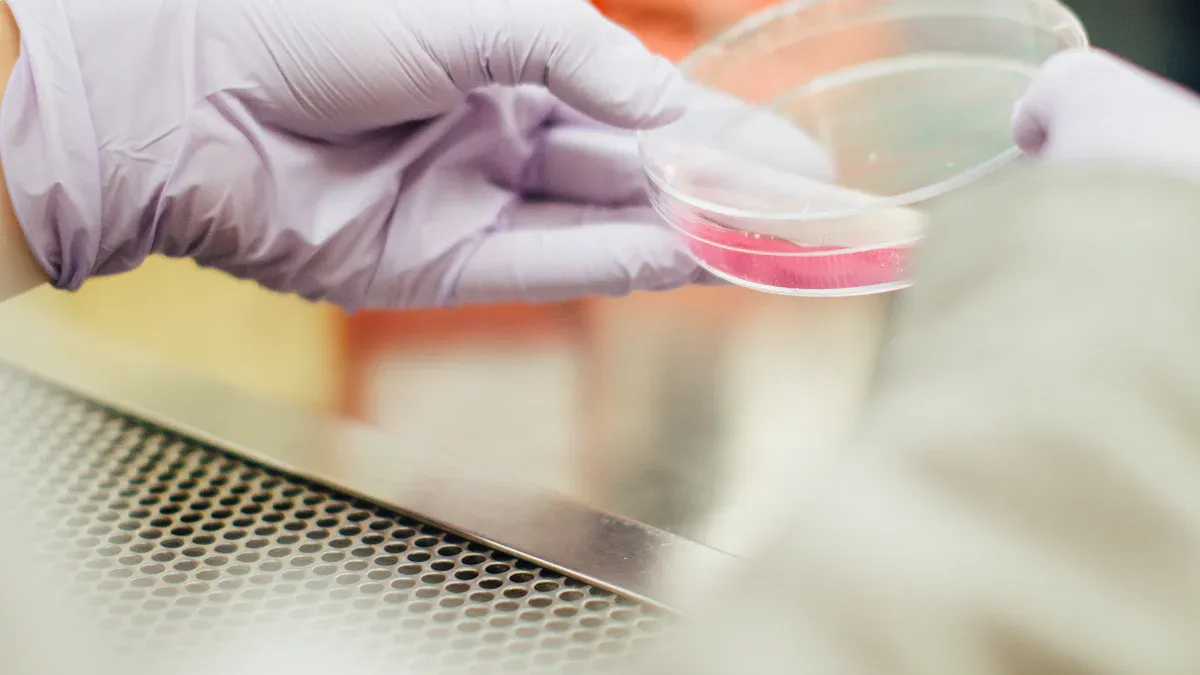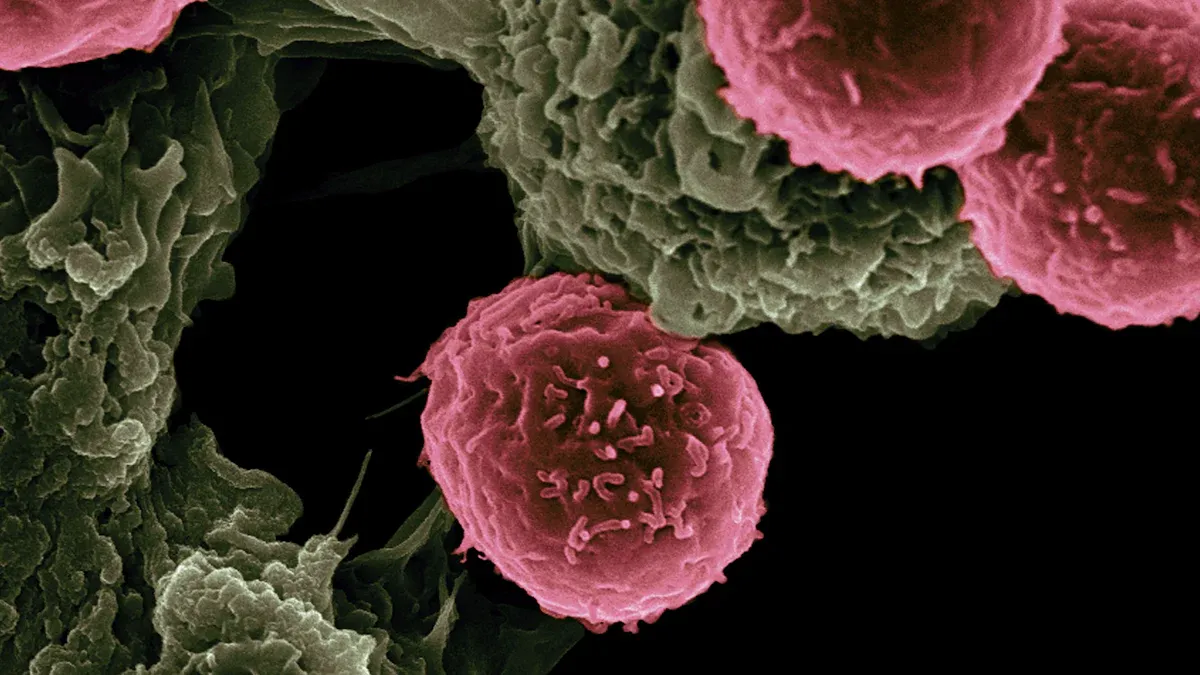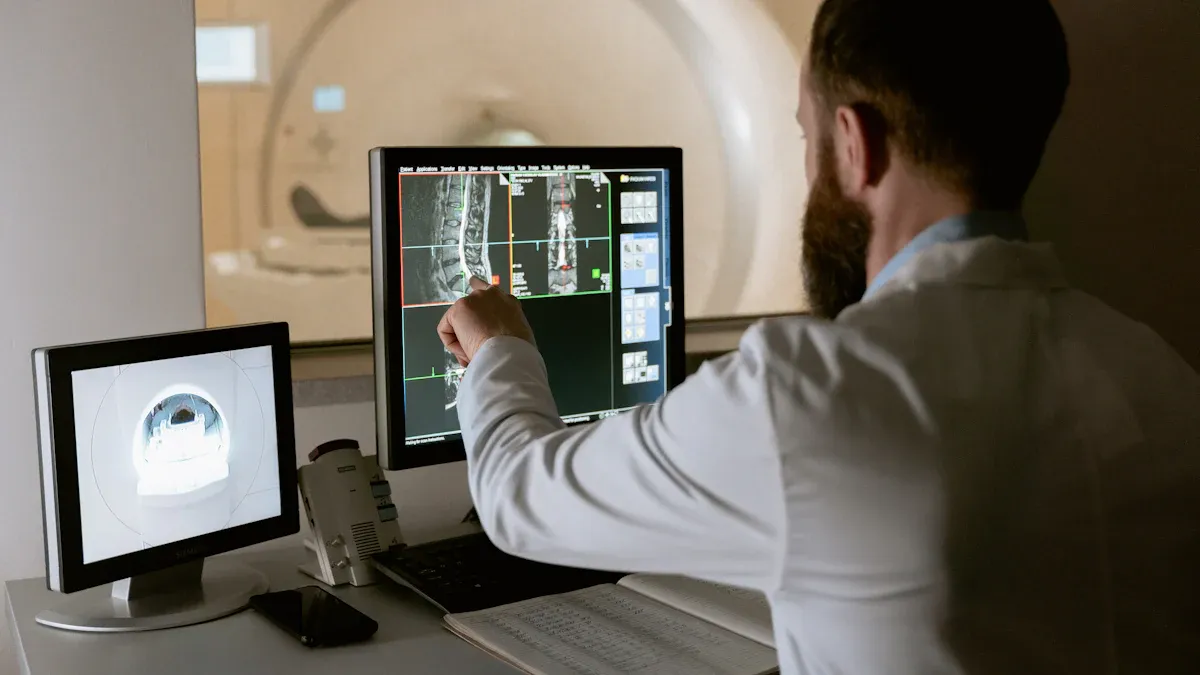Understanding Biopsies and Their Role in Cancer Detection

A biopsy is a medical procedure where doctors remove a small sample of tissue or fluid from your body for examination. This process plays a vital role in identifying cancer. It helps doctors determine if a suspicious area contains cancerous cells. For example, needle biopsies, like fine-needle aspiration, detect cancer in 60% to 90% of cases. Surgical biopsies, which provide more comprehensive samples, confirm cancer in up to 98% of cases. Early detection through biopsies improves treatment outcomes and increases survival rates. Understanding Biopsies: Types and Their Roles in Cancer Detection is essential for recognizing their importance in modern medicine.
Key Takeaways
A biopsy is an important test to check for cancer. It looks at tissue samples to find cancer cells.
There are different kinds of biopsies, like needle or surgical ones. Surgical biopsies can find cancer in about 98% of cases.
Liquid biopsies, like blood tests, are less invasive. They help find cancer markers and track how cancer grows.
Getting ready and taking care after a biopsy is key. Follow your doctor’s advice to stay safe and get good results.
Biopsies are usually safe with few problems. Knowing how they work can make you feel calmer and more prepared.
Understanding Biopsies: Types and Their Roles in Cancer Detection

Needle Biopsies
Fine-Needle Aspiration (FNA)
Fine-needle aspiration (FNA) is a minimally invasive procedure. Doctors use a thin needle to extract a small sample of cells or fluid from a suspicious area. This type of biopsy is often used to examine lumps or masses in areas like the thyroid, breast, or lymph nodes. FNA is quick and typically performed in an outpatient setting. It has a cancer detection rate ranging from 60% to 90%, making it a reliable option for initial diagnosis.
Core Needle Biopsy
Core needle biopsy involves using a larger needle to remove a small cylinder of tissue. This method provides more detailed information than FNA because it collects a larger sample. It is commonly used for breast, prostate, or liver biopsies. Studies show that core biopsies have a success rate of 77.1% when at least five cores are taken, with a low complication rate of 0.3%. This makes it a valuable tool for accurate cancer detection and molecular analysis.
Skin Biopsies
Shave Biopsy
Shave biopsy involves removing the top layers of skin using a small blade. It is often used to diagnose skin cancers like basal cell carcinoma or melanoma. This method is quick and requires minimal recovery time.
Punch Biopsy
Punch biopsy uses a circular tool to remove a deeper sample of skin, including the epidermis, dermis, and sometimes subcutaneous tissue. This technique is ideal for diagnosing rashes or skin lesions that extend below the surface.
Excisional Biopsy
Excisional biopsy removes an entire lesion or tumor along with some surrounding tissue. It is often used when doctors suspect melanoma or other aggressive skin cancers. This method provides a comprehensive sample for histopathological evaluation, which is critical for determining treatment strategies.
Endoscopic Biopsies
Bronchoscopy
Bronchoscopy involves inserting a thin, lighted tube through your nose or mouth to examine the lungs and airways. Doctors use this method to collect tissue samples from the lungs, especially when diagnosing lung cancer. Endoscopic biopsies like bronchoscopy are versatile and allow for precise sample collection based on the tumor's location.
Colonoscopy
Colonoscopy is a procedure where a flexible tube with a camera is inserted into the rectum to examine the colon. During this process, doctors can remove polyps or take tissue samples for biopsy. This method is essential for detecting colorectal cancer at an early stage. A study of 522 plugged core biopsies showed a high histological diagnosis rate of 96%, highlighting the effectiveness of endoscopic biopsies in cancer detection and molecular analysis.
Understanding Biopsies: Types and Their Roles in Cancer Detection is crucial for recognizing how these procedures aid in early and accurate cancer diagnosis. Each biopsy type plays a unique role, ensuring that doctors can tailor diagnostic approaches to your specific needs.
Surgical Biopsies
Incisional Biopsy
An incisional biopsy involves removing a small portion of a suspicious lesion or tumor for analysis. This method is often used when the lesion is too large to remove entirely or when doctors need a sample to confirm a diagnosis. You might undergo this procedure if your doctor suspects a malignant tumor in areas like the musculoskeletal system. Studies show that incisional biopsies are highly reliable. For example:
Out of 332 incisional biopsies performed on patients with malignant tumors, only six required repetition due to invalid results.
The remaining 326 biopsies provided valid diagnoses, achieving a diagnostic accuracy of 100%.
Sensitivity and specificity rates for malignant tumors were both reported at 97.6%.
These statistics highlight the effectiveness of incisional biopsies in cancer detection and diagnosis.
Excisional Biopsy
An excisional biopsy removes an entire lesion or tumor along with some surrounding tissue. This method is often recommended when doctors suspect aggressive cancers or when the lesion is small enough to be removed entirely. By analyzing the entire sample, doctors can determine the cancer type, stage, and whether it has spread. This comprehensive approach makes excisional biopsies a critical tool in cancer treatment planning.
Liquid Biopsies
Blood Tests
Liquid biopsies, such as blood tests, offer a non-invasive way to detect cancer. These tests analyze blood samples for biomarkers, like proteins or genetic material, that indicate the presence of cancer. They are particularly useful for monitoring cancer progression or recurrence. Blood tests are less invasive than traditional biopsies, making them a convenient option for you if you require frequent monitoring.
Circulating Tumor DNA (ctDNA)
Circulating tumor DNA (ctDNA) is a groundbreaking advancement in cancer detection. Researchers have developed techniques to temporarily increase ctDNA levels in the bloodstream, improving detection rates. A study published in Science revealed that higher ctDNA levels enhance the diagnostic capabilities of liquid biopsies. Experts believe this innovation could address significant challenges in cancer diagnostics. Liquid biopsies, including ctDNA analysis, are transforming how doctors detect and monitor cancer, offering a less invasive yet highly effective alternative to traditional methods.
Understanding Biopsies: Types and Their Roles in Cancer Detection is essential for appreciating how surgical and liquid biopsies contribute to early and accurate cancer diagnosis. These procedures ensure that doctors can tailor treatments to your specific needs, improving outcomes and quality of life.
What to Expect Before, During, and After a Biopsy

Preparing for the Procedure
Preparation for a biopsy depends on the type of procedure you will undergo. For most biopsies, your doctor will provide specific instructions. These may include fasting for a few hours or avoiding certain medications. If you are undergoing a skin biopsy, preparation might involve cleaning the area. For more invasive procedures, like a liver biopsy, anesthetization is a critical step. On average, anesthetization and preparation take about 12.25 minutes, which accounts for 26% of the total procedure time.
To ensure accuracy, doctors follow strict protocols. For example, liver biopsies have a success rate of 95.02%, while other routine biopsies achieve up to 98.32%. Complications, such as minor bleeding or infection, occur in only 3.3% of cases. These statistics highlight the safety and reliability of biopsy preparation.
Biopsy Type | Success Rate (%) | Complications |
|---|---|---|
Liver Biopsy | 95.02 | 3.3% |
Routine Biopsies | 98.32 | N/A |
What Happens During the Biopsy
During the biopsy, your doctor will collect a tissue or fluid sample. The process varies by biopsy type. For instance, a needle biopsy involves inserting a thin or core needle into the targeted area. In contrast, a skin biopsy may require removing a small section of skin using a blade or punch tool. The sampling itself is quick, taking only about 3 minutes, or 6% of the total procedure time.
The entire procedure typically lasts between 44 and 51 minutes. Doctors prioritize precision to ensure the sample is adequate for analysis. This step is crucial, as up to 70-80% of medical decisions rely on pathology results from biopsies.

Pain Management and Recovery
Pain management is an essential part of the recovery process. Most biopsies involve minimal discomfort. Local anesthesia is often used to numb the area, ensuring you feel little to no pain during the procedure. Afterward, you might experience mild soreness or bruising, which usually resolves within a few days.
Recovery times vary depending on the biopsy type. For example, skin biopsies require minimal downtime, while surgical biopsies may need a longer recovery period. Following your doctor’s aftercare instructions can help minimize risks like infection or bleeding. Results are typically available within 2-3 days, though complex cases may take up to 10 days.
Tip: Keep the biopsy site clean and dry to promote healing and reduce the risk of complications.
Potential Risks and Complications
Biopsies are generally safe, but like any medical procedure, they carry some risks. Understanding these potential complications can help you feel more prepared.
Common Risks
You might experience minor bleeding, bruising, or soreness at the biopsy site. These issues usually resolve within a few days. For skin biopsies, infection is rare but possible. Keeping the area clean and following aftercare instructions can reduce this risk.
Less Common but Serious Complications
In rare cases, biopsies can lead to more significant issues. For example, percutaneous liver biopsies have a reported rate of 24 major complications per 1,000 patients. These include severe bleeding, which occurs in 0.48% of cases. Minor bleeding happens less frequently, at 0.19%. While the risk of death is extremely low—0.01%—it is important to be aware of this possibility. Out of 64,356 procedures reviewed in a clinical study, only 12 deaths were reported.
Note: Your doctor will take every precaution to minimize these risks. Advanced imaging techniques and careful planning ensure the procedure is as safe as possible.
Factors That May Increase Risk
Certain factors can raise your risk of complications. These include underlying health conditions, blood clotting disorders, or the use of blood-thinning medications. If you have concerns, discuss them with your doctor before the procedure.
By understanding these risks, you can make informed decisions about your care. While complications are rare, knowing what to expect can help you feel more confident and prepared.
Interpreting Biopsy Results
Timeline for Receiving Results
The time it takes to receive biopsy results depends on the type of analysis required. For most standard biopsies, you can expect results within 2-3 days. However, if your doctor orders more extensive testing, such as molecular or genetic analysis, the process may take 7-10 days.
Timeline Type | Duration |
|---|---|
Standard biopsy results | 2-3 days |
Extensive testing required | 7-10 days |
Your doctor will explain the expected timeline based on the type of biopsy and the tests being performed. While waiting for results can feel stressful, this time is crucial for ensuring accuracy and providing a clear diagnosis.
Accuracy of Biopsy Results
Biopsies are highly reliable for cancer detection. Studies show that incisional biopsies for musculoskeletal tumors have a sensitivity of 97.6%, with 100% concordance to histopathologic diagnoses when re-biopsies are performed. This means that biopsies rarely miss cancerous cells when the sample is adequate.
Other studies highlight the overall accuracy of biopsies:
Specificity varies between 41–95%.
Accuracy rates fall between 0.70–0.94.
Study | Sensitivity | Specificity | Notes |
|---|---|---|---|
da Silva et al. | 0.99 | 0.93 | 579 slides from 100 patients |
Perincheri et al. | 0.977 | 0.993 | 1876 biopsy slides |
Musculoskeletal tumors | 0.976 | N/A | 332 incisional biopsies with 100% concordance |
These statistics demonstrate the reliability of biopsy results, helping doctors make informed decisions about your care.
What Abnormal Results Might Indicate
Abnormal biopsy results often indicate the presence of cancerous or precancerous cells. However, the interpretation depends on factors like tumor type, size, and location. For example, neuroendocrine tumors tend to yield more tissue during biopsies compared to appendiceal tumors due to differences in their microenvironments.
Other factors, such as patient characteristics, also play a role. Larger lesions typically provide better samples, while patients with lower BMI face fewer challenges during the procedure. Age-related changes may also affect biopsy adequacy, with younger patients sometimes experiencing selection bias in clinical trials.
If your results are abnormal, your doctor will discuss the findings and recommend the next steps. These may include additional tests or starting a treatment plan tailored to your specific diagnosis.
Biopsies play a crucial role in detecting and diagnosing cancer early, which improves treatment outcomes. These procedures are safe and reliable, as studies show no severe complications and a diagnostic accuracy of 95.4%.
Evidence Type | Findings |
|---|---|
Complications | No complications reported |
Valid Diagnosis Rate | 100% concordance with pathology |
Major Complication Rate | Only 0.3% |
Doctors use advanced techniques to minimize risks and enhance diagnostic success. If you suspect any health concerns, consult a medical professional. Personalized guidance ensures you receive the best care possible.
FAQ
What is the difference between a biopsy and a blood test?
A biopsy removes tissue or fluid for analysis, while a blood test examines your blood for markers like proteins or DNA. Biopsies provide detailed information about a specific area, while blood tests offer a broader overview of your health. Both methods help detect and monitor cancer.
Are biopsies painful?
Most biopsies cause minimal discomfort. Doctors use local anesthesia to numb the area, so you feel little to no pain during the procedure. Afterward, you might experience mild soreness or bruising, which usually resolves within a few days. Always follow your doctor’s aftercare instructions for a smooth recovery.
How safe are biopsy procedures?
Biopsies are generally safe. Minor risks include bleeding or infection, which occur in less than 3% of cases. Advanced imaging and careful planning reduce complications. For example, liver biopsies have a success rate of 95%, with major complications reported in only 0.48% of cases.
Can a biopsy confirm cancer?
Yes, biopsies are the gold standard for cancer diagnosis. Pathologists examine the sample under a microscope to identify cancerous cells. Biopsies also help determine the cancer type, stage, and whether it has spread, guiding your doctor in creating an effective treatment plan.
How long does it take to recover from a biopsy?
Recovery time depends on the biopsy type. Skin biopsies heal within a few days, while surgical biopsies may require a week or more. Keeping the biopsy site clean and following your doctor’s advice can speed up healing and reduce complications.
Tip: Avoid strenuous activities during recovery to prevent irritation or bleeding.
See Also
Recognizing Duodenal Cancer Symptoms And Available Treatments
An In-Depth Overview Of Various Cancer Types
Exploring Ductal Carcinoma In Situ And Its Signs
